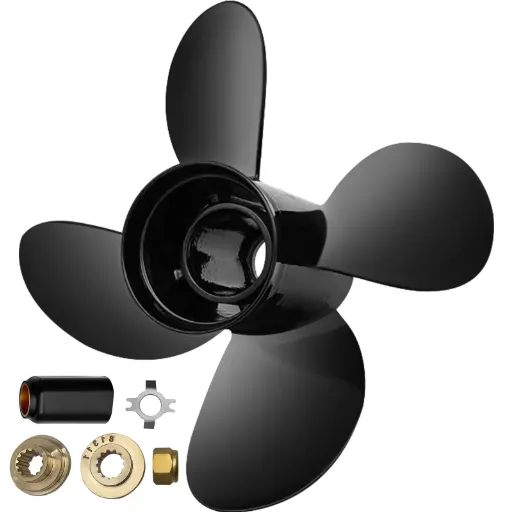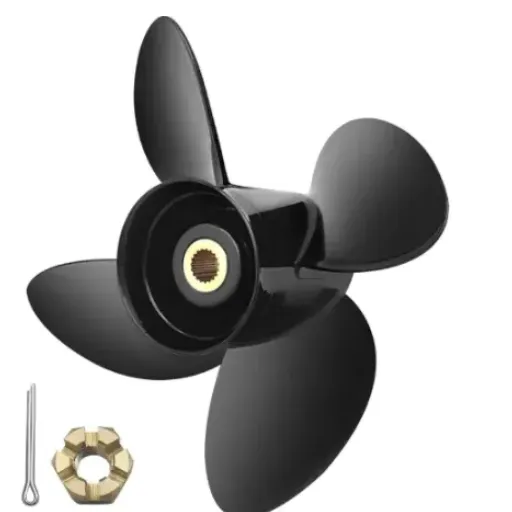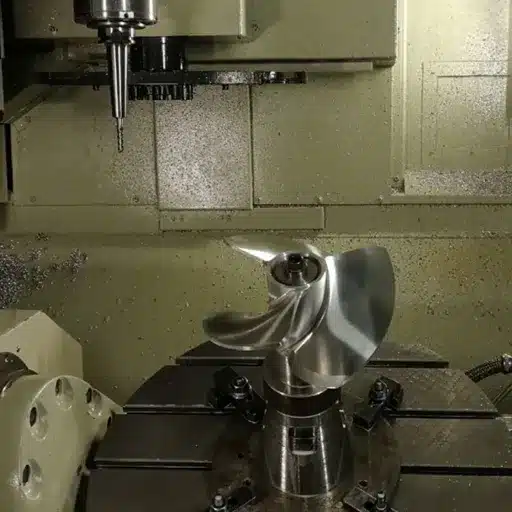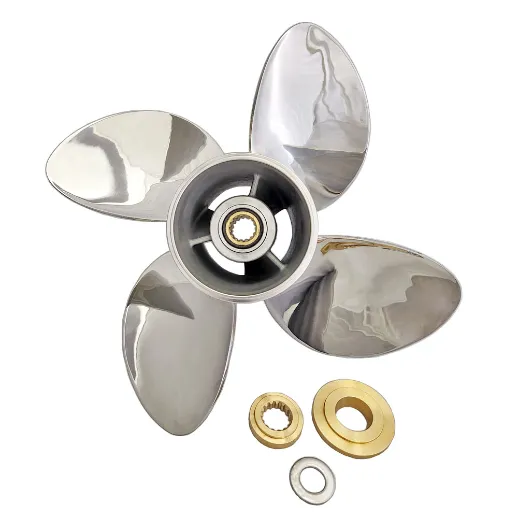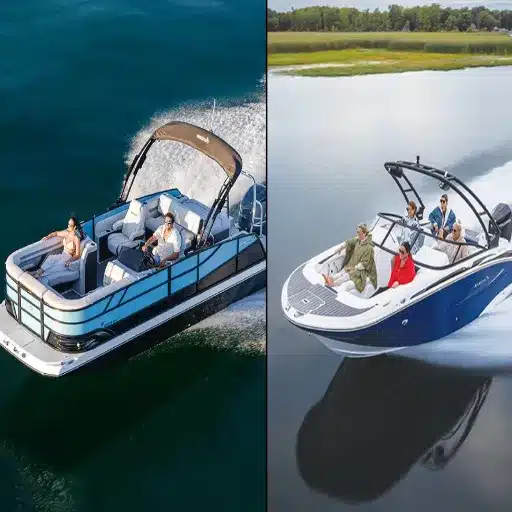The right prop size is indeed one of the critical considerations for optimizing a boat’s performance, along with efficiency, speed, and handling characteristics. Good prop optimization ensures your vessel is on peak performance while taking her through different conditions, from calm lakes to rough seas. With developments in marine technology and performance needs changing in 2025, it seems that picking the right option is a challenging decision. The guide will examine the top five factors to consider when deciding on a prop size for your boat and distill the more technical aspects into concise, straightforward points you can act on. By the time you finish reading this article, you’ll be armed with the knowledge needed to make an informed decision that suits your vessel as well as your particular boating needs.
Understanding Propeller Size and Its Impact on Boat Performance
What Is Propeller Diameter?
The propeller diameter denotes the complete width of the circular path described by the blades in their rotation. Another crucial aspect that affects the thrust imparted on the boat and hence its performance is the diameter. To measure the diameter, it is either twice the length from the center of the propeller hub to the blade’s tip or obtained from the manufacturer’s data. Larger diameters are usually associated with boats that demand more thrust at lower speeds, such as tugboats or heavy loads. In contrast, smaller diameters are used for high-speed applications due to less drag.
Several factors determine optimum propeller diameter, such as engine power, gear ratio, and hull construction. For instance, a boat with a high-horsepower engine and lightweight construction usually does better with a smaller-diameter propeller for optimum speed. In contrast, a larger-diameter propeller is preferred under the operating conditions where torque and pulling power take priority. This balancing ensures that the propeller works with the engine and vessel to achieve any desired performance objectives.
The Importance of Propeller Pitch
The pitch of a propeller is the distance the propeller theoretically moves through a solid medium in one complete revolution of the blades; it significantly affects vessel performance. A lower-pitch propeller produces increased pulling power, and so, it ought to be used for towing or hauling heavy loads. This means that the power available for maximum speed will be less. High-pitch propellers, however, can be used to attain a greater top speed with lighter vessels, since they are meant to cover more distance in each revolution under ideal circumstances.
To give an example, testing data showed that a propeller with a 19-inch pitch might allow a moderately powered speedboat to touch speeds close to 45 knots, depending upon variables such as engine horsepower and the weight of the gunwale. If we reduce it to, say, a 17-inch pitch, acceleration and load-handling ability would be enhanced, but top speed would be cut down to 40 knots. A proper understanding of these operational dynamics would ensure operators meet their performance requirements for speed, fuel consumption, or loading ability when choosing propeller pitch. Therefore, choosing the correct pitch is not based on some theoretical rule but involves a thorough consideration of vessel characteristics and operational requirements.
How Propeller Size Affects Speed and Efficiency
The propeller size, generally measured by its diameter, is a peculiar factor in gaining a given speed and efficiency for a boat or any other watercraft. A propeller of great diameter interacts with a greater amount of water in each rotation; hence, the thrust produced at low RPM levels is greater. This makes a big propeller much more suitable for heavier and slower vessels, such as cargo vessels, where fuel efficiency and load handling come first, rather than promoting speed.
On the other hand, it is said that propellers with a smaller diameter are the best for light and fast vessels because these generate less drag and resistance with rotation. These allow the engine to reach higher revolutions per minute, thus providing quick acceleration and reaching its utmost speed. But the trade-off is in less torque and perhaps less efficiency in carrying heavy loads.
Secondly, empirical data suggest optimization lies in striking a balance between diameter, pitch, and blade design. Choosing an optimum propeller size involves careful calculations of the gross power output of the engine, cruising speed, and displacement of the vessel. CFD simulation and field testing are frequently employed to fine-tune these selections and ensure the best propeller configuration for real-world applications, ultimately achieving a balance between speed and efficiency.
Choosing the Right Propeller for Your Boat
Factors to Consider: Boat Type and Usage
In choosing the appropriate propeller for a fine boat, it is essential to consider the type of boat and its primary use. Recreational motorboats for water skiing and wakeboarding require a high-thrust propeller to achieve quick acceleration and maintain a consistent tow speed. In contrast, fishing boats prefer propellers that offer fuel economy at a consistent cruising speed; therefore, a propeller with three or four blades and moderate pitch is chosen.
Larger commercial vessels, such as cargo ships and ferries, generally require propellers suited for heavy load applications under long operating cycles. Hence, larger diameter propellers are often employed at low rotational speeds to provide maximum thrust and minimize cavitation under such high load conditions. Precision-balanced propellers for racing boats with higher rake angles and special materials offer opportunities for speed and agility rather than fostering fuel economy.
A comprehensive analysis once more refines the decision-making process. The data comprised load distribution, speed requirements, engine specifications, and the operational environment —whether fresh water, salt water, or variable conditions —to influence the choice of propeller materials for durability or corrosion resistance. Correlating these factors to advanced engineering considerations ensures the optimization of performance, which is thus tailored to the needs of the vessel.
Matching Propeller Size to Engine Power
Designing propellers for optimum performance hinges on the critical matching of parameters. Paramount among these are propeller diameter and pitch. To illustrate: If the power curve and maximum rpm are not matched with the propeller’s design data, the engine will never deliver its best, while having an undersized propeller forces the engine to over-rev, thereby reducing the life of the engine or, in some cases, outright failure. The other extreme of using an oversized propeller to overload an engine slows it down, thereby causing it to have poor acceleration, if at all, or outright stall.
For compatibility optimization, the propeller slip equations and mathematical models are used to assess the relationship between vessel speed, engine torque, and thrust output. Data collected under certain real-world operational conditions, such as the weight of the load and hull resistance, further enhances such an evaluation. Modern techniques of computational fluid dynamics (CFD) simulations and hydrodynamic testing proffer a clearer perception of the water flow characteristics, thus enabling the design of propellers for particular power outputs and vessel requirements.
Using Propeller Charts for Selection
Propeller charts are crucial for determining the power-to-propeller sizing and pitch relationship and must be carefully selected to optimize propulsion efficiency and fuel consumption. The charts typically describe the mechanism involving engine revolutions per minute (RPM) of the propeller and boat speed in relation to propeller size. This way, operators can choose configurations that give maximum thrust and minimum cavitation. With modern development, increased accuracy has been achieved in preparing these charts using data accrued from real-time testing and simulations.
For example, the manufacturers today integrate variables such as gearbox ratios, shaft configurations, and environmental factors like water temperatures and salinities into the models. In this way, the reasoning emphasizes obtaining the finest advice on selecting the propeller, ensuring balanced performance tailored to an array of operational conditions within the range. Correct interpretation of such charts would take into account specific parameters of the vessel, such as hull type, load capacity, and usage parameters. Thus, if the operators use appropriate and specific propeller criteria based on these data sets, they will be able to achieve propulsion with much greater efficiency, reduce wear and tear on the propeller, and extend vessel life.
Evaluating Propeller Material and Design
Common Materials Used in Boat Propellers
The choice of materials for boat propellers is an important consideration, requiring a balance of strength, durability, corrosion resistance, and performance efficiency. Common materials include aluminum, stainless steel, and bronze, with each having specific advantages and areas of application.
Aluminum
Aluminum is a widely used propeller material because it is lightweight and cheap. It is strong enough for vessels that are either recreational or light duty, and relatively easy to repair if damaged. It is, however, a less durable material when exposed to abrasion or corrosion.
Stainless Steel
Stainless steel propellers are known for their superior strength and corrosion resistance. The effectiveness of such propellers is maximized in high-performance and heavy-duty operations, such as speedboats or bath vessels operating in saltwater conditions. Stainless steel propellers are a step higher in price than aluminum, yet their long life and enhanced efficiency usually make them worth the investment.
Bronze
A traditional material famous for its corrosion resistance, particularly in marine environments. It is mainly applied in larger commercial vessels, trawlers, and professional-grade applications. The resistance against wear and tear ensures reliability through long operation periods; however, it is heavier and more expensive than aluminum and stainless steel.
Composite Materials
Recent developments have introduced most composites that combine characteristics of lightweight and competitive durability. These propellers are often reinforced with advanced fibers, offering a corrosion-resistant and cost-effective alternative for specific use cases, especially for small or medium boats.
These are some of the operational parameters on which the choice of propeller materials depends: vessel size, usage, operating environment, and budget. Operators should weigh the trade-offs between durability, effectiveness, and price, ensuring the chosen material fits the vessel’s performance specifications and maintenance capabilities.
New Designs For Performance
New designs in propellers have introduced innovative geometry and materials that enhance performance and are being used in various maritime applications. One of the prominent innovations is blade design optimized through computational fluid dynamics (CFD). This involves precise modeling of fluid interactions to ensure the propellers minimize hydrodynamic drag and maximize thrust and efficiency. The development of skew and highly-cupped blades has, for example, demonstrated the ability to withstand better or resist cavitation and handle water flow conditions equally well.
Furthermore, the use of composites, which are engineered blends of carbon fiber and reinforced polymers, enhances weight savings and corrosion resistance. They are often best suited to vessels that have to work in aggressive marine environments. Variable pitch propeller methods ({VPP}s) allow further upgrading by changing the blade angle during operation to achieve optimal performance at varying loads and speeds. This provides operators with more options for fuel consumption and emission reductions, all without affecting nozzle power. With state-of-the-art software tools working alongside advanced material science, these designs are creating new milestones for efficiency and sustainability in the field of maritime propulsion systems.
The Trends of Propeller Manufacturing for the Year 2025
The business of making propellers will experience modern growth and development toward 2025 by integrating new technologies with an environmentally conscious approach. In the forefront of such trends is the increasingly prevalent use of additive manufacturing for prototype and final production. This particular process offers advantages such as precise customizations of propeller geometries, reduced material wastage, and shorter lead times, which overall decrease the manufacturing time.
The job is ICT-related, and CFD simulations are conducted at nearly every stage and for virtually any purpose during the design phases. Use of sophisticated CFD tools enables engineers to modify blade profiles for enhanced hydrodynamics with reduced cavitation and better performance of the vessel. Also on the rise are advanced composites like carbon fiber reinforced polymers, whose strength-to-weight ratios and corrosion-resistance increase the fuel economy and life of the propeller.
More and more IoT sensors are being installed in propeller systems, ensuring condition monitoring in real time and predictive maintenance. The sensors provide data on operational parameters such as vibration, temperature, and wear, limiting downtime and increasing operational reliability. In a way, all these trends technically improve the propellers and comply with global regulations on reducing emissions and seeking cleaner shipping options.
Common Mistakes in Propeller Selection
⚠️ Ignoring Diameter-Pitch Compatibility
Selecting the wrong diameter-pitch combination can lead to performance and mechanical issues. The diameter of the propeller is the diameter of the circle left in the water by the tip of a blade of the propeller. At the same time, pitch is the distance the propeller theoretically advances in one revolution through a unitary solid medium like water. These two contrasting aspects must be balanced according to the engine power, respective speed, and conditions under which a vessel mainly operates.
For example, a propeller with an insufficiently large diameter can strain the engine, thereby increasing fuel consumption or creating overheating. A too-high pitch is a case in which greater engine load, lesser speed, and acceleration are applied. Studies show that a mismatched diameter and pitch may reduce propulsion efficiency by at least 15-20 percent, adding unnecessary overhead costs to the owner over time. Proper matching between pitch and diameter allows the engine to operate in its desired RPM band, ensuring minimum wear, optimal fuel savings, and emissions compliance. Pickup navigation of pitch and diameter yields going through manufacturer specifications and sea trials to confirm the selection is worthy of design life.
⚠️ Ignoring Manufacturer Suggestions
Inefficiencies and eventual equipment damage are the severest consequences of not respecting manufacturer recommendations. A manufacturer designs a system and its components according to the manufacturer’s rigid specifications, ensuring they work best under varying operating conditions. For example, disregarding propeller dimensions, specifically engine power recommendations, would disrupt the delicate balance of thrust-engine load, thereby increasing fuel consumption and leading the system toward mechanical failure. Some studies have found that under-calibration of any system would reduce its overall efficiency by about 10-15% and lead to significant operational costs within a short time.
Also, warranties might be denied, unplanned stresses could be applied to systems, and accelerated wear could occur if the prescribed maintenance intervals are not followed or if any spurious replacement parts are used. Industrial performance data show that unscheduled downtime due to such factors can be almost five times the in-plant costs that would have been incurred if preventive maintenance scheduling had been followed. Hence, following the manufacturer’s directions is not only a recommendation but also a risk-mitigation and cost-control measure.
⚠️ Underrating Environmental Factors
Applying environmental conditions will render operational efficiency, longevity, and a safe working environment for complex systems. Factors such as excessive heat or cold, high humidity, dust, and exposure to corrosive substances put them under stress, often preventing the systems from performing well in their designed operations. For example, high humidity could facilitate short-circuiting in electrical systems or corrosion on critical components, whereas overheating could degrade lubricants and accelerate the degradation of the materials themselves. It is statistically shown that equipment running under unfavorable circumstances requires maintenance in half to a third of the time compared to when it is in a controlled environment.
At the same time, particulate matter in the air, such as dust or industrial debris, can clog vents and enter delicate mechanisms, blocking the cooling processes. Such accumulations deny efficiency and pose a danger of system overheating or mechanical failure. These hazards emphasize the importance of assessing and mitigating environmental variables during the design and operational phases of any system. One can implement protective measures such as climate-controlled enclosures, industrial-grade seals, and regular cleaning of the systems. All of these have been shown experimentally to reduce failure rates and extend the operational life by up to 40% in aggressive environments.
Case Studies: Successful Propeller Selections
Real-Life Examples of Propeller Optimization
Looking at optimizing the cases thrown toward success, maritime stands out in my mind. I remember studying the application of advanced CFD models for the design optimization of container ship propellers. With CFD simulations, the engineers could determine the trade-off between blade geometry and cavitation and hydrodynamic efficiency. One 2022 example is a case study involving the redesign of the propeller blades of a container vessel based on these simulations, which resulted in 8% less fuel consumption than the conventional design. Apart from saving 8% in costs, significant strides were made towards minimizing greenhouse gas emissions—a much-needed improvement in today’s environmentally-conscious shipping industry.
Another relevant example is propeller development for fuel-efficient turboprop aircraft. With composites and aerodynamic fine-tuning, propeller manufacturers have been able to create designs that are lighter and more durable while reducing drag to maintain thrust efficiency. Another optimization method of pitch and chord length adjustment helped a major aircraft company achieve a 10% increase in the range of their regional commuter planes. This shows that material innovation combined with aerodynamic discipline still offers novel interpretations of system performance, even in a well-established technology. Such examples clearly justify the need for modern engineering tools and data-driven methods to improve propellers. From the results, one can conclude that systematic optimization enhances performance, thereby placing propulsion technologies on a foundation of sustainability and cost-efficiency.
What We Learned from Propeller Miscalculations
From my analysis, one of the most critical lessons learned from propeller miscalculations was the failure to consider proper aerodynamic modeling throughout the entire design procedure. Errors in measurement in terms of parameters such as blade pitch, curvature, and even velocity-thickness turbulence flow will strongly affect performance. For instance, considering the dynamic environmental profiles, such as crosswinds or varying altitudes that alter thrust output levels, can have detrimental effects on operational reliability and fuel efficiency. Early-stage CFD simulation-assisted designs can prevent such eventualities by rendering an excellent appraisal of how pressure distribution and airflow behave over the ups and downs on the blades.
Another essential takeaway is the importance of real-world testing with genuine application alongside simulation models. Ignoring theoretical assumptions or classical design principles could mean that the design has become misaligned with the requirements of today’s operations. This is evident, for instance, in propulsion issues concerning improved energy efficiency or adaptation to hybrid technologies, which may be applied to entirely new parameters. Validation via wind tunnels or sea trials, if only periodically, would have ensured that underperformance actually results in an optimized product. Now, a combination of high-fidelity simulation tools with iterative testing procedures will help steer a good cohabitation between design innovation and a well-grounded benchmark for performance. In essence, learned lessons emphasize that, rather than focusing on expensive inefficiencies and better propeller effectiveness, the key is a balance of precision engineering and a systematic, data-driven approach.
Data-Driven Insights into Propeller Performance
After thorough research and considering the most recent findings, I boldly assert that the complete optimization of propeller performance must be approached in a multifactorial manner, incorporating both theoretical modeling and empirical grounding. Nowadays, computational fluid dynamics (CFD) is essential for this. These simulation tools allow for a detailed understanding of the interactions between fluids and structures, enabling one to accurately envision flow behavior, thrust efficiency, and cavitation chances before even proceeding to a prototype. Successive iterations in design help maximize aerodynamic efficiency by reducing the drag and noise of the propeller through CFD simulation, which are significant in marine and aerospace applications.
IoT and internet-connected sensor data collection in operational environments has genuinely changed the way propeller performance is assessed during varying conditions. It provides in-situ review of parameters, including rotational speed, torque, and vibration patterns, and analyzes them to determine sources of inefficiencies and potential imbalances. By adopting machine learning techniques, this data can be used to detect trends and arrange predictive maintenance schedules, significantly improving reliability and lifespan while simultaneously decreasing incidences of sudden failures.
Ultimately, in a data-driven methodology, the design and manufacturing processes are fine-tuned to ensure that changes in operational requirements are accounted for and applied to the final product. One should use top simulation tools combined with real-world performance data to form the backbone of a strong approach to increasing the efficiency, sustainability, and performance requirements currently faced by propeller systems.
Reference Sources
- LFS Marine – Boat Propeller Fit Guide: Explains how propeller sizes are labeled and the importance of diameter and pitch.
- Captain’s Preferred Products – How to Measure a Boat Propeller: A step-by-step guide to measuring diameter, pitch, blade count, and hub size.
- Newport Vessels – Propeller Sizes and Benefits: Discusses the benefits of different propeller sizes and blade configurations.
- LFS Marine – Boat Propeller Fit Guide (Duplicate): Another detailed guide on understanding propeller size labeling and its impact on performance.
- Propeller Selection Basics – General Knowledge: Offers insights into how propeller size affects speed, fuel efficiency, and engine performance.
- Find more info now.
Frequently Asked Questions (FAQs)
❓ What is the significance of correctly selecting your boat’s propeller?
Choosing the right propeller is very important for the boat’s efficient operation. A properly selected propeller will ensure that at wide-open-throttle (WOT) RPM, the engine operates near its maximum RPM value. A propeller with excessive diameter may not let the boat plane, whereas the one with a lesser diameter may allow for over R.P.M. with slow acceleration. The diameter and pitch dictate the amount of thrust available to move a boat and its top speed. With some knowledge of propeller selection, you indeed find it more fun to go boating.
❓ How do I determine the suitable propeller diameter for my boat?
Boat weight, use, and engine specifications should be considered before settling on a diameter for the propeller. Typically, the larger the prop diameter, the more power it can transmit into thrust. Another consideration is the gear ratio of your outboard motor when choosing prop size. Prop diameter should be in direct proportion to the engine horsepower. Manufacturers often provide recommendations regarding prop size.
❓ What is the relation between prop pitch and boat performance?
The pitch of a propeller is an essential element in the performance of any boat, especially when it comes to acceleration and top speed. A lower pitch may bring acceleration quicker, but it may limit the maximum speed because of spinning so fast at WOT-throttle. On the other hand, a higher pitch prop will improve top speed while lowering acceleration. Understanding propeller pitch is therefore essential for any boater who wishes to optimize performance for their particular needs. Adjusting the pitch will let you balance power and speed the way you want.
❓ How do you change the prop size for faster acceleration?
If someone is interested in acceleration improvement, they would probably choose a lower-pitch propeller. Such a propeller would enable the boat to reach higher RPMs more quickly and hence speed up. But the same adjustment should not discourage the boat from reaching its top speed. Additionally, consider how the total weight of the ship affects the load on the prop. A proper balance must be struck between diameter and pitch, so that acceleration is sufficient and performance is not impaired.
❓ Which factors should I keep in mind when selecting a prop model for my outboard motor?
While selecting a prop for your outboard motor, think about a boat’s weight, intended use, and engine specifications. Seek props fitting your engine’s horsepower and gear ratio for still higher performance. Adding to that, the number of blades influences a lot in performance; however, a four-blade prop gets thrust generation more for heavy boats. For speed, a three-blade prop works more efficiently. Stainless steel is a good choice of material for props, offering more durability and better performance.
❓ When should a propeller be replaced?
Significant damage, such as dents, cracks, and corrosion, should be grounds to replace your propeller, as these can affect its performance. Other indicators that may signify prop replacement are a decline in the boat’s performance and being unable to reach the recommended Wide Open Throttle (WOT) RPM. Changes due to aging and wear can affect the thrust and acceleration characteristics of your prop; therefore, regularly checking can let you know when it is time to replace it, ensuring the efficiency and performance of your boat.




